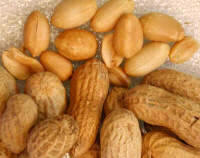Peanuts
Information about peanuts plus peanut recipe
collection
Â
|
Ingredient
of the
Month
|
Scroll
down for Peanut Recipes
|
March
2007 |
Â
Click
here for previous Ingredients of the Month
Â
Â
 Although peanuts (genus Arachis species hypogaea) are considered to be nuts
culinary wise, botanically they belong to the legume family Fabaceae which
includes other food plants such as beans, lentils, soybeans and peas and
ornamental flowers including lupins. Although peanuts (genus Arachis species hypogaea) are considered to be nuts
culinary wise, botanically they belong to the legume family Fabaceae which
includes other food plants such as beans, lentils, soybeans and peas and
ornamental flowers including lupins.
Â
They are also commonly known as groundnuts,
earthnuts, goobers, jack nuts, pinders and when still in their shell, monkey
nuts.
Â
Â
Origin and History of Peanuts
Peanuts are believed to be of South American origin with archaeological evidence
showing that they were cultivated as far back as in prehistoric times in
Argentina and Brazil, where the wild strains can still be found, and the Spanish
explorers found them on sale in the market places in Mexico by the time they
arrived in the early 16th Century. The Portuguese transported peanuts to Africa,
and in turn, African slaves popularised them in the USA to where they were
transported as slaves.
Although ancient South American Indians were the first to make and eat peanut
butter, it was reinvented by a physician in St. Louis c1890 as a health food for
the elderly. Around about the same time c1895, Dr. John Kellogg (of cornflakes
fame) patented the process of making peanut butter for patients at his
Sanatorium in Michigan. In 1903 Ambrose Straub patented a machine for making
peanut butter.
Today peanuts are grown throughout the tropics, Asia, Africa, Australia,
Southern USA and their native South America, with India and China accounting for
over half of the world's production.
Â
Peanut Varieties
For market purposes, there are four basic types of peanuts Runner, Virginia,
Spanish and Valencia each of which consist of several "varieties" all grown for
their distinct characteristics which make them more suitable for cultivating in
different regions.
Runners are largely grown for processing into peanut butter, Virginias for
roasting, Spanish which have smaller kernels are mainly used in peanut sweets,
snack nuts or peanut butter and Valencias which are very sweet peanuts and are
usually roasted and sold in-the-shell.
Â
Cultivation and Processing of Peanuts
The names groundnut and earthnut are derived from the fact that as the pods
ripen, they are forced underground. An annual plant, peanut seeds are planted
with specialist machinery about 5cm/2-inches deep every 10cm/4-inches in rows
about 90cm/three feet apart preferably in sandy calcium-rich soil. Once the
plant has flowered, the shells and kernels start to develop after approximately
8 weeks and reach full maturity during the next 10 to 12 weeks.
A mechanical harvester is used which has long blades that run 15cm/6-inches
beneath the ground which loosen the plants and cuts the roots. Immediately
behind the blades, a shaker lifts the plant from the ground, shakes it then
turns it over and replaces in on the earth (peanuts side up) where they are left
to dry for a couple of days. The peanuts are then separated from the vine and
further mechanically dried usually with hot air blowers transported to peanut
mills to be further cured cleaned, stored, or processed in various ways such as
oil, roasting, peanut butter production or peanut oil production.
Â
Peanut butter production
Raw shelled peanuts are roasted and cooled, then the skins are removed and
sometimes the kernels are split to facilitate the removal the hearts of the
peanuts which can be saved to make peanut oil. The peanuts are then ground until
very smooth during which process they are heated to about 170F. Emulsifiers are
then blended in after which the butter is quickly cooled to below 120F which
crystallises the emulsifiers. Chunky peanut butter is made by adding peanut
granules to the smooth peanut butter.
Peanut oil production
Peanut oil can be extracted by one of three methods: hydraulic, expeller and
solvent. The hydraulic method extracts the oil by means of pressing shelled
peanuts under 14,000 psi, whilst adding steam and heat. The Expeller method
extracts the oil by means of feeding the peanuts into a grinder then applying
pressure, forcing the pulp through a perforated screen which separates the oil
from the mass. The solvent method involves the chemical hexane, which is applied
to the cracked nuts and which draws out the oil from the nut. The oil-solvent
mixture is then heated to about 150C/300F which evaporates the hexane.
Â
Peanuts in cooking
Peanuts are regularly used in many Asian and African cuisines, particularly in
savoury dishes such as Satay (sate) and African Peanut Stew. They are an
excellent source of extra protein, vitamins B and E and minerals including
magnesium, copper, phosphorous, potassium and zinc. They are fast gaining
popularity in western savoury dishes as well as being used in the old time
favourites such as peanut butter biscuits.
Peanut oil is an ideal oil for cooking because it can be heated to very a high
temperature (230C/450F) before it smokes which is hotter than most other cooking
oils. This enables food to cook more quickly which absorbs less oil. It has the
added bonus of not having a strong flavour plus the fact that it doesn�t take on
flavours of food cooked in it and so can be reused without fear of transferring
flavours from one food to another.
Â
Happy Cooking!
Â
Â
CLICK HERE FOR LOTS
OF RECIPES USING PEANUTS
|
|